Sarah Hawkes, a Conservation Officer working with Buglife on the Scarce Yellow Sally project, spent April and May on the hunt for the illusive target species as part of Natur am Byth's routine survey work.
She kept a diary of her findings throughout this season as keen eyed followers may have seen on her social media channels.
We thought these diary entries were a great glimpse into the day to day life of our officers and the work that they do to help Wales' most vulnerable species, so we thought we'd collate them here for all to see. Enjoy!
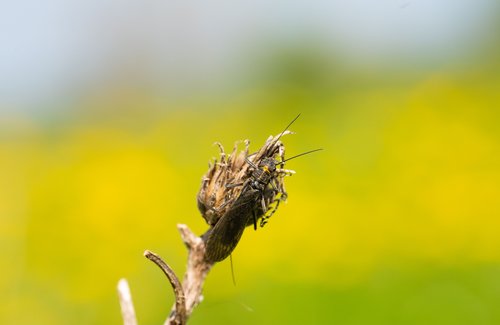
I don't suppose stoneflies will ever have the social media appeal of lambs, but Scarce Yellow Sally Stonefly surveying season is underway and along the River Dee we are beginning to see the adult flies, (longish dark coloured, about 2cm, If you see one that looks right, please put a photo here or in a message!). They are vanishingly rare and only occur in the UK on the Dee/Ceiriog in Wrexham County so far as we know.
Nonetheless, I am going down to the Severn near Welshpool for a look, just in case.
Fingers crossed!
The best thing is, they are easiest to see on bridges and fence posts in the sunshine!
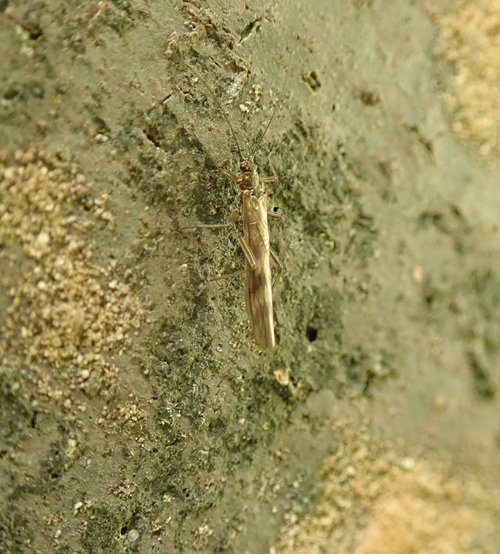
The trip to the Severn with my Andrena Bee expert friend Clare Boyes was an absolute delight, tho' in terms of stonefly finding all but fruitless. I wanted to check out bridges for exuvia left behind as the nymphs morphed into adults -hoping a population of Scarce Yellow Sally might have been missed and we were trampling around riverbanks figuring out which bridges were accessible south of Welshpool.
We sort of know the answer, but there is something about checking for yourself. The river at Berriew was beautiful and we had a lovely time wading about checking the walls for stoneflys. We did find one live Brachyptera risi and a Perlodes exuvia.
However, at other bridges than the Berriew bridge and aqueduct, invasive plants, Giant Hogweed, Japanese knotweed and Himalayan balsam have taken a real hold and the hogweed in particular makes the banks impenetrable.
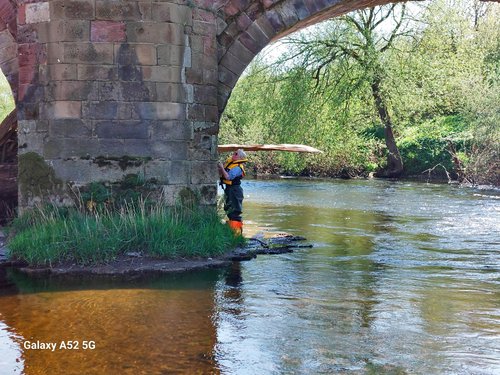
On Friday I spent the morning at Bangor on Dee Bridge in the company of David Andrews, who wrote a early paper on finding Scarce Yellow Sally in the Dee, published in 1984.
I'd been down earlier and collected the remaining exuvia from the bridge (photo by Mary Thompson of an earlier exuvia collection visit) - where I found barely any had emerged over the preceding week, so they must have finished emerging from the river now.
Then I spent the rest of a fascinating morning enjoying tales of all things river related from Davids career looking at river; the pollution events that had run through the Dee over the years (from Phenol that caused the taps to run 'tcp' to Whey that killed hundreds of fish by causing bacterial blooms and was hard to identify because it was not a toxin, as such, but a nutrient).
And many more stories, utterly fascinating and especially valuable to me, who has got seriously involved with stone flies and the River Dee only in the last 2 years.
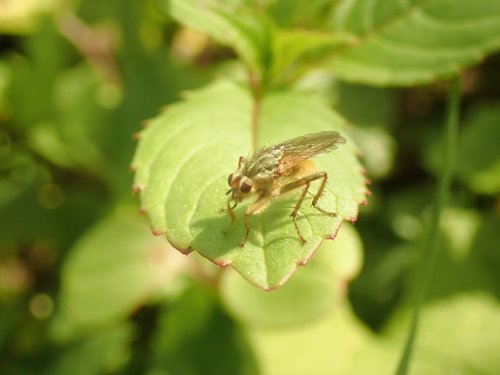
Sunday at Bangor on Dee searching for Scarce Yellow Sally along the river with Alan from Chester Zoo Aquarium. We found honey bees, harlequin ladybirds, alder beetles, hoverflies including one victim of a fungal attack, Yellow dung flies and a pretty little Mayfly. called a Dusky Yellow Streak, but not a single stonefly over 3 hours. It was a bit too windy perhaps? but I like to think we honed our technique for searching (!) We are sure they are there, we have the shed skins they emerged from.... but where?
We have talked to lots of people out for walks or a pint at the riverside pub; - plenty of potential searchers who now have leaflets. Which is a result.
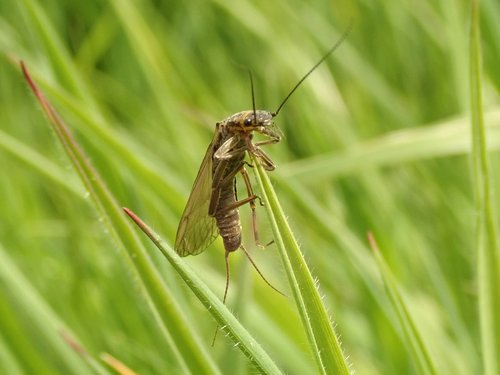
Hooray!!! we have found our first adult 'Scarce Yellow Sally Stonefly' this year! Alan from Chester Zoo Aquarium and I were hunting along the bank. I had found a Perlodes stone fly (which is slightly bigger and more common) when a Sally flew over and landed on my leg.
From that point we found many in a small area and watched them landing on grasses, sometimes flying a little way. Watching and speculating about why they might be doing what they were doing kept us busy for a long time.
We also caught 8 to record the 'drumming' they do to call each other. (In itself that was a bit of an adventure; I managed to put two into a tube together that were opposite sexes - not the plan in case the ensuing mating put them out of the mood for drumming!)

Having caught them I was left with a bit of a problem. I had not been able to bear the thought of ordering empty cardboard boxes on line for some extortionate sum each, so had nothing ready as a recording studio!
On the way home I stopped at Stans to look, thinking perhaps of large match boxes. Happily, as I walked in there was a pile of mini cereals packs on offer, perfect size and food grade clean so safe for Sally's to live in for a night or two before going back to the river!!
With the recorder set up and the Sally's drumming (not as exciting as it sounds, a few -up to 6- quiet taps now and again) I had the recording I wanted.
I am left with 8 little packs of cereal and have a stonefly sound studio set up - win win!
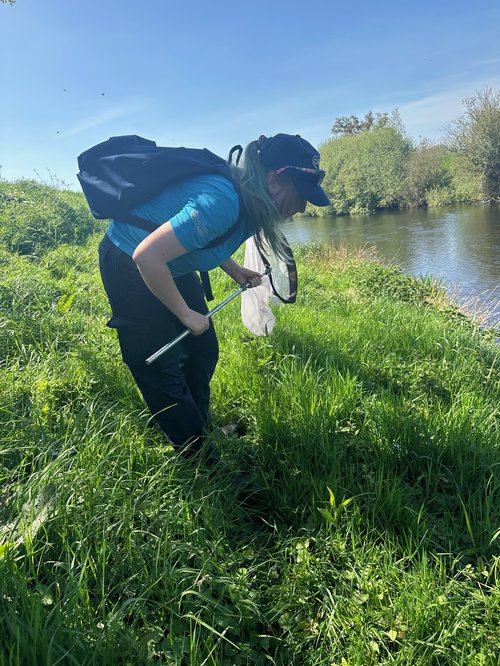
After 2 nights of sound recording with my little band of drummers, the drummers have gone back to the river and their beats have gone off for analysis. Whilst handing them over I was able to listen to another stonefly species rhythms - no louder, but much faster than the laconic Sally and more buzzy. I am asking Tim to get onto it for his next insect featuring song!
Imogen and Katie from the Bug department at the Zoo came out to the river on a couple of days and together we gathered lots of footage of the stonefly's mating, searching grasses, settling on trees and some images of the egg masses. I am hoping to get some better photos of the latter if we can get lucky with the weather and finding more animals later this week.
Alan, Mel and Kaitlyn came over yesterday to help search the Ceiriog, but no luck so far and I have not been able to get to the bridge to see if there are any exuvia on the walls - the water is too deep even for waders! We did find a lovely Violet Oil Beetle, and a pretty Snipe fly at one of the Dee sites!
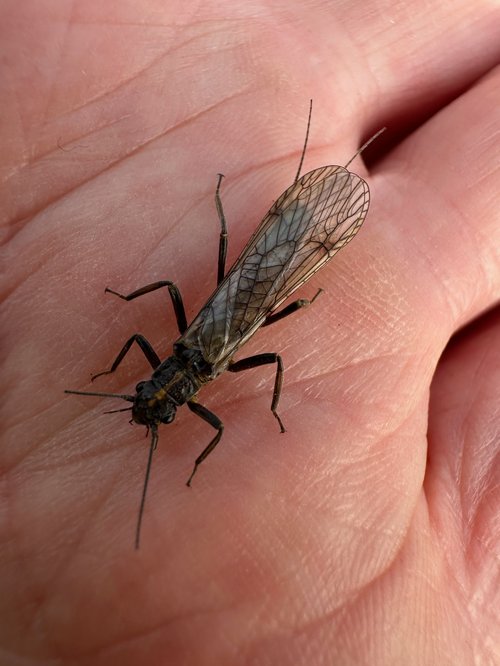
Imogen from Chester Zoo and I set off for an evening's Sally hunt on the coldest day for ages after a frost early this morning. The forecast was OK, but not inspiring so it was touch and go whether I could justify asking for volunteers so I took Eira the dog as a companion in case there was nothing else to look at. In fact we found 24 Scarce Yellow Sallys in the trees, of which 6 were mating pairs.
It is so nice to be able to look and watch them, knowing that almost nothing is known about their behaviour.
We can ask ourselves the most naive questions and they are as valid as any other. That is really what this year's survey is for, to look and wonder why, ready to follow up with more targeted questions next year.
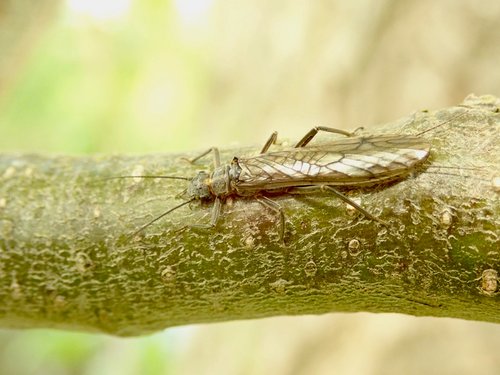
The endgame is upon the Scarce Yellow Sally, there are fewer and fewer of them each time I visit.
On Friday it was lovely to have Justin Williams, a local naturalist, along to see this rarest of Wrexham's animals. After searching for a while, we did manage to find some of the last few Sallys in the trees and the thistles.
Down by the River Dee now it's the turn of the Mayflies. Ephemera danica are dancing vertically, up and down over the riverbank, fragile Pale Watery Mayflies settle on the vegetation, Alderflies, Click Beetles and Sawflies are all coming out to take their places as the season moves on.
It won't be long now before you can spot the Yellow Mayfly, Potamanthus luteus that has only recently moved North to the Dee - all the way from the Usk in the South - following the warming climate.
Having spent the last month and more (the flight season for my particular stonefly of interest - Isogenus nubecula) along the banks of the River Dee in NE Wales on footpaths next to pasture land & steep riverbanks, I am in whole hearted agreement that farming, and industry, supported by us as consumers creating demand, is the key to nature recovery and a positive future.
Of course, I am including our drinking water and river playgrounds as well as habitats for the biodiversity on which we depend to keep our rivers healthy.
Listen here to James Rebanks who is committed to finding practical, workable ways in his field (pun not entirely intended!) through this dark period to produce good healthy food and good healthy countryside. I've long admired his books and viewpoint.
Along the Dee there are some excellent practices and some great opportunities to improve both river animal and farm outputs, as well as resilience to climate change.
Did you know that riverflies, which take up so many niches in the river and out of it during their flight seasons, are fundamental to riverbed and bank stability? Manmade declines in biodiversity are fuelling problems, but luckily, invertebrates, insects and soil microbes, have mechanisms to bounce back and support us all. We just have to look after our landscape and rivers with respect for life and enable them to get on with their lives without poisons that do none of any good.
We aren't helpless.
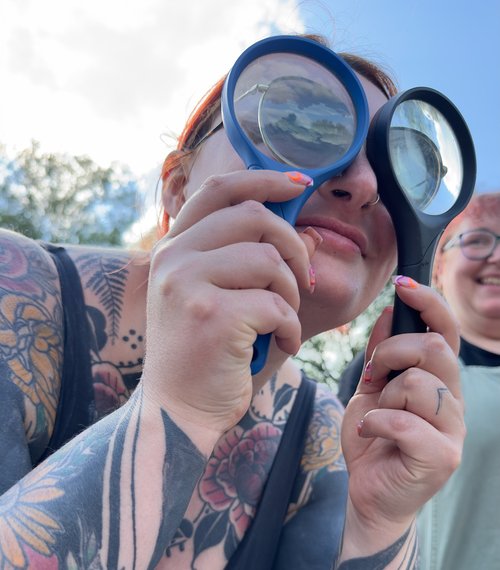
Now the survey season has ended I have started the summer's ‘engagement events’ for Scarce Yellow Sally with a day taking the Wrexham Uni Fine Arts Students to the river Dee. We walked along the banks, looked at inverts and the river, discussed their ideas for art works (and their wonderful first creations) that are interpreting their thoughts about insect ecology and headed up along the river as far as the sand martins’ nest site.
Debbie said, looking at an insect on a fence post, ‘What’s this?’ ‘A scarce yellow Sally,’ I replied.
Tracy found one too and before we knew it there were 4 stoneflies (possibly 5 but one may have come round again for a second look)!
My confident prediction of the end of the season was obviously way off and I was hoist by my own petard!: How many times have I answered volunteer questions with ‘We just don’t know the answers yet but that is where you come in’!!?
So, here we are into June. In 2024 the last sighting was May 6th, this year I thought we'd seen the 'last straggler' on 23rd May. But Scarce Yellow Sally has other ideas and in a moment of serendipity, the lovely art students had stepped delightedly into the volunteer vacuum!
What a brilliant day for us all. And to ‘ice the cake’ - not that it needed it - we found large Potamanthus Mayfly larvae in the kicksamples (when I was showing them our survey methods), ready to emerge as sub imagos at their next moult. (Another target species for this project, about to become a flying river fly!)